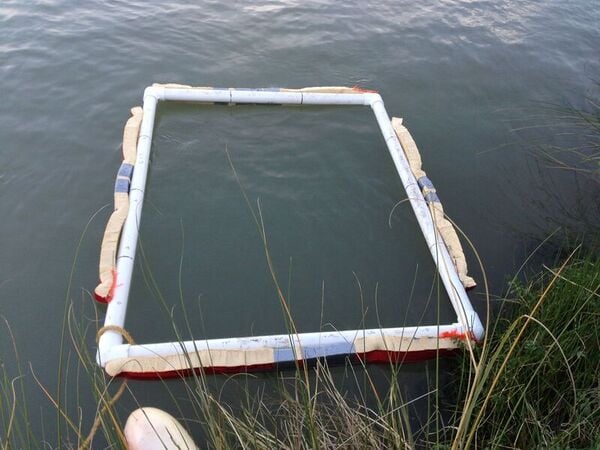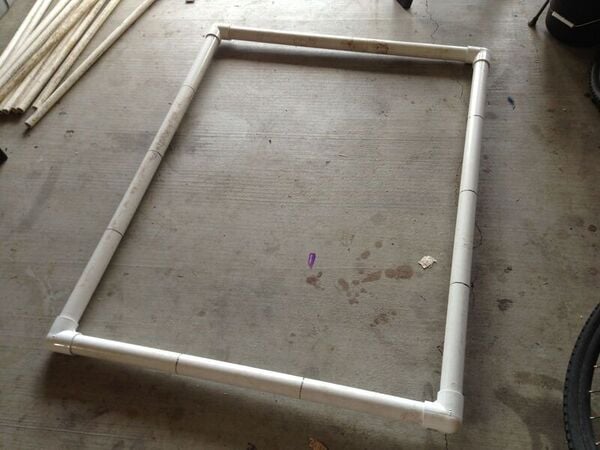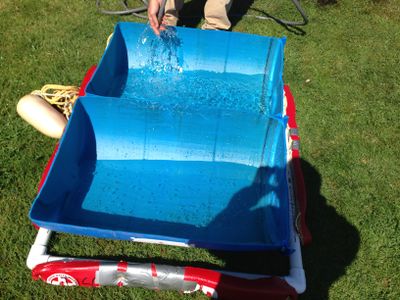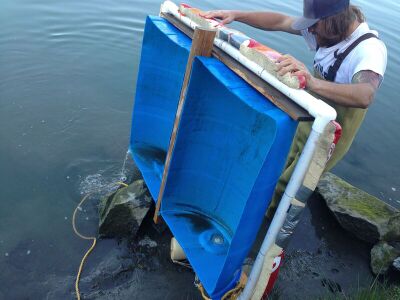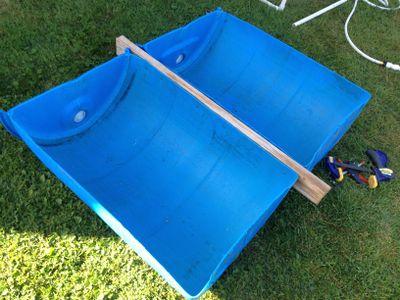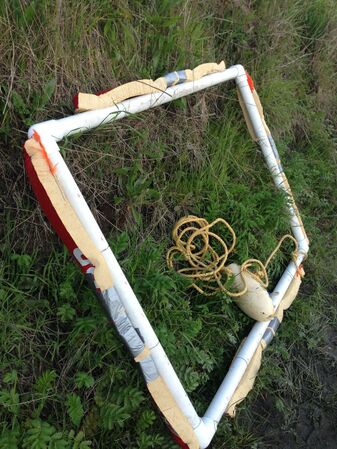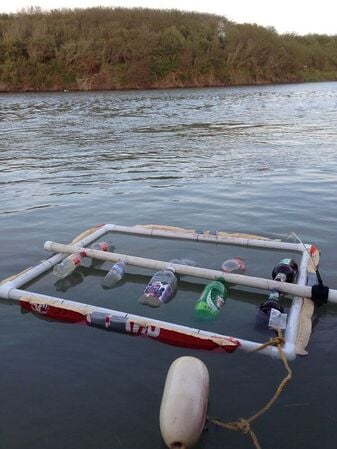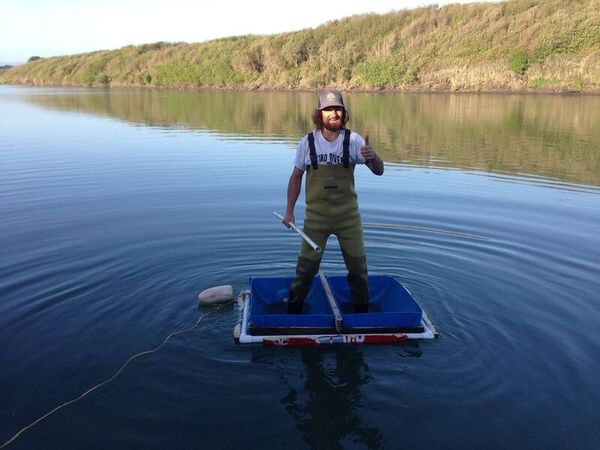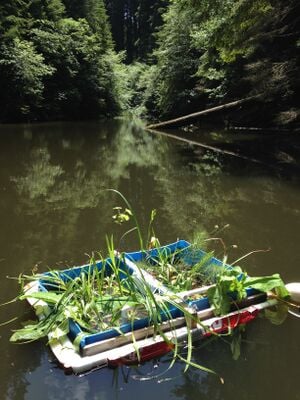
The WetLand bog can provide sustenance, promote increased water quality, provide habitat and will serve as a working educational platform. WetLand bog is designed to inspire environmentally friendly means to meet the challenges of coming generations. WetLand bogs seeks to serve as a model for potential sustainable resource expansion and development.
The project is an initiative by New York artist and sculptor Mary Mattingly, who designs sustainable installations and alternative living models.
Background[edit | edit source]
WetLand is a floating island that illustrates a partially-submerged house surrounded by a human-made bog. The interior of the house is functional and contains a live, work, and enclosed performance space with: a dry compost toilet, kitchen with sink and shower that utilize purified rainwater. A 40x20x3' flat deck barge and two access gangways composes the primary infrastructure. A greenhouse in a structure adjacent to the submerged house contains vegetables grown hydroponically, a natural grey water filtration system, and soil-based produce. WetLand's railings around the perimeter are also made into planters, and floating planters around the perimeter include bulrush, cattail, and veining plants that all naturally clean the water.
What: As environmental instability continues to transform our cities, what happens when the land we use is only temporary? WetLand is a mobile, sculptural habitat and public space atop a barge made to explore solutions for sea-level rise, housing, resource interdependence, and a decrease in useable land.
Events will be programmed with FringeArts. Residents will live on board and host events, from workshops to skill shares. High school and college students in Philadelphia will help steward the space, collect data about energy use and production, and test and maintain onboard water systems.
Where: WetLand will be constructed at Pier 9, across from FringeArts in Old Town, Philadelphia. It will be tugged to Penn's Landing adjacent to the Seaport Museum and open to the public on August 15, 2014.
When: WetLand will launch August 15th on the Delaware River at Penn's Landing through September 31, 2014.
Why: WetLand is a narrative approach to inhabiting a future Philadelphia with accelerated environmental challenges that are interconnected and everywhere, including lack of clean water, usable land. This is at once a visually engaging structure but also a working living system narrated by its users, who look to a time when people are again dependent on the nearness to the water. WetLand is an experiment that uses water in various ways: To float, to desalinate river water for growing plants, to tie up to or launch from, and to bridge urban space with nature. The waterfront is often under-appreciated and underused that has potential to bring together a site and communities. When activated, the site brings people to the nature that lies on the edge of the city and effectively brings interdependence between both of those spaces to the forefront.
WetLand addresses the importance of decentralizing our basic resources by using appropriate technology to create a regenerative water-based living system that provides food grown from cleaned river water, power from sun and tides, shelter for living and events, collected and purified rainwater for all other needs. We need to work together to build cities that connect, heal, and empower. We need people living in cities that join the city with nature who can care for it and work out an idea of nature that includes human culture and livelihood.
How: Building supplies for WetLand are reclaimed from the local waste stream to further narrate a future when reuse is common and parts are made with found materials. This project will be completed through FringeArts, the James L. Knight Foundation, and the partnerships we make together.
Who: WetLand is sponsored by The James L. Knight Foundation with FringeArts. For more details including additional partners contact studio@marymattingly.com and sarah@fringearts.com. Coming soon: www.wet-land.org
Problem statement[edit | edit source]
The objective of this project is to design a floating bog to provide inspirational awareness to alternative sustainable environmental design. The floating bog is to be placed in the Delaware River alongside the WetLand barge which will be moored in a prominent part of downtown Philadelphia. The floating bog will be used throughout the duration of the WetLand project and serve as an educational platform of alternative water treatment techniques. The crew aboard the WetLand barge may choose to plant the bog with edible plants for added sustenance. The ability to manually monitor the quality of the bog water will play an essential role in the educational component and promote community engagement.
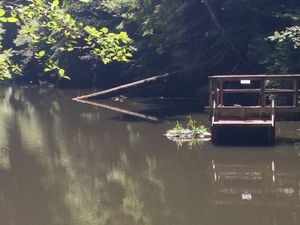
Literature Review[edit | edit source]
This is a review of the available literature pertinent to the prototype WetLand bog to be constructed for the WetLand barge in Philadelphia, PA.
Wetlands Wetlands are described as areas that are saturated with water for extended periods of time and support vegetation specifically adapted thrive in saturated soil. Wetlands are generally transitional areas between open water and dry land.[1]Historically wetlands were regarded as economically useless land. Wetlands support a variety of plants species including bulrushes, mangroves, sedges and cordgrass. Many of the plants that inhabit wetland areas have proven to be sufficient at filtering and removing pollutants from water.[2] Wetlands provide a variety of ecological services including water filtration, habitat for waterfowl and other wildlife and serve as a buffer zones against erosion and rising water.[3]
This biome occupies roughly 6 percent of the world's surface and enhances the global cycling of water. These natural lands have been use and abused by society and are one of the most threatened ecosystems. Rapid industrial and social changes that effect the environment are undermining the conservation efforts of wetlands, development efforts such as the WetLand bog can help alleviate this unique natural commodity. Wetlands comprised of very diverse habitats that are vital to multiple dimensions of global resources and ecological substance.[4]
Floating Wetlands With the transformation of waterfronts in coastal areas to industrial centers the water quality and loss of valuable habitat have come into question. Many coastal cities have begun to explore the validity of small scale floating wetland projects to restore ecological services to their shorelines and waterways. Constructed ecosystems in urban areas may prove to improve conditions. Floating wetlands may prove to provide invaluable ecosystem services to these once natural areas through functions such as pollutant uptake, habitat creation and increased aesthetic appeal. One promising case is in the city of Baltimore, Maryland. Beginning in 2010 two separate floating wetland installations tripled the coverage of wetlands and by 2012 the coverage area increase to 2,000 square feet. The productivity and ultimate success of floating wetlands is yet to be determined, but the practice has been going on for over two decades in some regions. Many cultural obstacles stand in the way of floating wetland installations such as regional policy and funding. But the future of floating wetland systems appear promising.[5]
Invasive Plants Invasive plants are characterized as any plant species that is non-native to an area that after introduction have the ability to out-compete the native flora.[6] Many plant species, either native or non-native, have the potential to become invasive. Plants that fall under this heading have the potential to invade or degrade areas. Invasive plants evolved in areas other than the area where they are classified as invasive. Their evolutionary traits allow them once introduced to new areas to surpass the native flora in nutrient uptake, space and in some cases introduce new pests and diseases that can have devastating effects to local flora. Invasive plants have the ability to crowd out native species, and are generally better at some facets of a plant species life cycle then the native species. Invasive's are often hard to control and can become prolific given enough time.[7] Plants native to one area are not necessarily invasive in another. The distinction between invasive and newly introduced plants lies in a species ability to overtake native flora in an area other then were they evolved.
Vegetation Wetland vegetation is the primarily component that will thrive and prolong the nature, mechanics and beauty that a wetland conveys. Wetland sensitivity such as hydroperiod, hydrodynamics and nutrient availability are depended on which type of wetland the plants will nurture. Several plant species and genera grow only in Salt to brackish marshes, freshwater marshes, freshwater swamps and peatland ecosystems.[8] Identifying the importance of each species habitat is indicative for the type of wetland one chooses to construct. Amongst the importance of wetland vegetation, some plants can have medicinal, and edible benefits. Some are both medicinal and edible, such as the Groundnut (Apios americana medik), which has three times the protein of potatoes. The medicinal value found in plants can be traced from Native American tribes that use plants for their medicinal significance. Tea made from the roots and leaves of medicinal plants is a favorable approach; medicinal plants can range from curing stomachaches, headaches, colds, to swellings.[9] In addition, a wetland is primarily consists of plants with water filtrating qualities. These plants natural ability to purify water can help with water quality assessments of turbidity, pH levels, alkalinity, toxic pollutants or substances (human health criteria for systemic toxicants) and biological monitoring..[10]
Project Evaluation Criteria[edit | edit source]
The following Criteria will be used to assess the success of this project. These criteria were chosen based on input from the artist and the team of students responsible for the design and construction of the prototype. The scale (1-10) represents the importance level of meeting the constraint of each listed criteria. 10 has the largest magnitude and decrease numerically in descending order.
| Criteria | Constraints | Weight (1-10) |
|---|---|---|
| Budget | Must be between $600-$1,000. | 10 |
| Aesthetics | Compliment the installation and increase appeal. | 9 |
| Vegetation | Plants must be adequate for the Delaware River regional climate, water quality, and be able to endure as it moves to New York. | 10 |
| Education | Educational aspect compliments the overall theme of the project. | 7 |
| Reproducibility | Can be easily recreated with readily available materials. | 8 |
| Functionality | Utilize the appropriate and most efficient water purifying and oxygen adding plants. | 9 |
| Materials | Recyclable materials preferred obtained from the Philadelphia area. | 9 |
| Maintenance | Be easily maintained with little to no expertise. | 7 |
Budget[edit | edit source]
The project will require a variety of new and re-purposed materials. Many of the new materials were purchased from local businesses and used materials were gathered from a variety of locations throughout Arcata, CA. Donated items include PVC, lifeguard buoy, nylon rope, and 2"x4" wood. Donors are listed as 'source' in the table.
| Quantity | Material | Source | Cost ($) | Project Cost ($) | Total ($) |
|---|---|---|---|---|---|
| 1 | 55 gallon drum | Water Planet Garden Supply | 32.38 | 32.48 | 32.48 |
| 5 | Pipe sch. 40 1"x 10' end cap | Ace Hardware | 0.80 | 4.00 | 4.00 |
| 3 | 1-1/14' x 10' PVC Pipe DWV | Ace Hardware | 0.89 | 2.67 | 2.67 |
| 1 | O-ring #35732 | Ace Hardware | 0.35 | 0.35 | 0.35 |
| 3 | O-ring #35740 | Ace Hardware | 0.45 | 1.35 | 1.35 |
| 1 | O-ring #35764 | Ace Hardware | 0.35 | 0.35 | 0.35 |
| 1 | Utility Hose 1/2" x 10' | Ace Hardware | 7.99 | 7.99 | 7.99 |
| 1 | Cement PVC 80Z | Ace Hardware | 5.99 | 5.99 | 5.99 |
| 5 | 3/4" PVC adapters | Ace Hardware | 0.59 | 2.95 | 2.95 |
| 1 | 1-1/4" couple SxS Sch. 40 | Ace Hardware | 0.99 | 0.99 | 0.99 |
| 1 | 3/4" T-fitting PVC sch. 80 | Ace Hardware | 3.99 | 3.99 | 3.99 |
| 1 | Teflon Tape | Ace Hardware | 0.99 | 0.99 | 0.99 |
| 1 | Insert male Adapter 3/4" | Ace Hardware | 2.99 | 2.99 | 2.99 |
| 1 | Slip Cap 1" | Ace Hardware | 0.99 | 0.99 | 0.99 |
| 1 | Plug Slip 3/4 | Ace Hardware | 1.99 | 1.99 | 1.99 |
| 1 | T-fitting 1" | Ace Hardware | 1.99 | 1.99 | 1.99 |
| 1 | Slip Cap 1" | Ace Hardware | 0.99 | 0.99 | 0.99 |
| 1 | reducer bush 1-1/4" | Ace Hardware | 1.99 | 1.99 | 1.99 |
| 1 | Slip Cap 1-1/4" | Ace Hardware | 0.99 | 0.99 | 0.99 |
| 1 | Nipple Sch. 80 PVC 3/4" close | Ace Hardware | 0.99 | 0.99 | 0.99 |
| 2 | check valve | Ace Hardware | 9.99 | 19.98 | 19.98 |
| 2 | 3/4" PVC nipple | Ace Hardware | 0.99 | 1.98 | 1.98 |
| 2 | 1.5" sch 40 Slip Cap | Ace Hardware | 1.50 | 3.89 | 3.89 |
| 1 | small screws (20) | Ace Hardware | 1.99 | 1.99 | 1.99 |
| 3 | O-ring | Ace Hardware | 0.35 | 1.05 | 1.05 |
| 1 | 90* Elbow 3/4" Sch. 40 | Ace Hardware | 0.79 | 0.79 | 0.79 |
| 20 | washers | Do it Best | 0.17 | 3.40 | 3.40 |
| 4 | 90* 1x1/2 PVC | Do it Best | 0.61 | 2.45 | 2.45 |
| 2 | small screws | Do it Best | 1.19 | 2.38 | 2.38 |
| 1 | 12' nylon rope | Donated | 5.00 | 0.00 | 0.00 |
| 4 | 6' x 1-1/4" PVC Pipe Sch. 40 | Donated | 30.00 | 0.00 | 0.00 |
| 5 | 18' x 3/4" PVC Pipe Sch. 40 | Donated | 30.00 | 0.00 | 0.00 |
| 1 | Lifeguard Bouy | Donated | 15.00 | 0.00 | 0.00 |
| 1 | 2"x4"x28" wood | Donated | 3.68 | 0.00 | 0.00 |
| 2 | 1" Bulkhead fitting | Bayside Garden Supply | 9.95 | 19.90 | 19.90 |
| 1 | 1" Barbed insert to 1" | Bayside Garden Supply | 0.55 | 1.10 | 1.10 |
| 1 | Barbed Insert Elbow | Bayside Garden Supply | 0.55 | 1.10 | 1.10 |
| 1 | 1" Black Tubing - 1" | Bayside Garden Supply | 1.45 | 1.45 | 1.45 |
| 2 | 3/4" to 1" male adapter | Do it Best | 1.99 | 3.98 | 3.98 |
| 5 | 90* 3/4" elbow | Do it Best | 0.59 | 2.95 | 2.95 |
| 1 | Nipple PVC 3/4" | Do it Best | 0.69 | 0.65 | 0.65 |
| 1 | Adapter Male 3/4" | Do it Best | 0.59 | 0.55 | 0.59 |
| 1 | 3/4" Threaded Coupling | Do it Best | 0.69 | 0.65 | 0.69 |
| 1 | 3/4" T-fitting | Do it Best | 0.69 | 0.69 | 0.69 |
| 1 | 3/4" Cap | Do it Best | 0.49 | 0.49 | 0.49 |
| 1 | 3/4" Female Hose x Female Thread Adapter | Do it Best | 4.49 | 4.45 | 4.49 |
| Sub-Total Cost | $158.01 | ||||
| Total Cost with California 8.25% sales tax | $165.63 | ||||
Timeline[edit | edit source]
Tentative timeline of tasks to date.
| Date | Task |
|---|---|
| March 2, 2014 | Create timeline and finish budget. |
| March 06-11, 2014 | Research and development of new ways to design Mary Mattingly's new bog idea. |
| March 12, 2014 | Assembling materials and designs. |
| March 20, 2014 | Contacting potential donors for needed materials and components. Begin contacted with HSU fisheries and Redwood Lab for PVC pipe donations. |
| March 29, 2014 | Begin construction of bog: gathered donated materials and built water pump. |
| March 30, 2014 | Built WetLand bog PVC frame. |
| April 2, 2014 | Begin testing PVC frame for buoyancy. Testing location was at Mad River in Arcata, California. |
| April 4, 2014 | Begin contacting Fern Lake, and the Arcata Marsh for potential test sites for the bog. |
| April 13, 2014 | Built 55 gallon drum frame. First Inlet and Outlet system built. Testing for buoyancy was done at the Mad River for almost an hour to check for steadiness as it was holding approximately 200lbs. |
| April 16, 2014 | Further research and development for Appropedia. |
| April 18, 2014 | HSU Plant Operation donations of Wood pellets, netting and plastic bottles gathered. Designing continued for scaling bog to 16'x3'. |
| April 20, 2014 | Finalize Inlet and Outlet System, build the wood frame attach to our 55 gallon drum. |
| April 28, 2014 | Contacted Sabine Mader from HSU fisheries department for final permission to place the bog in Fern Lake, Arcata, California. |
| April 29, 2014 | Daily monitoring and testing thru May 11, 2014 was done in Fern Lake. |
| May 2, 2014 | Fill 55 gallon drum about 1/2 way with water to test for buoyancy, and water resistance in Fern lake. |
| May 4, 2014 | Placed rocks inside the bog along with plants, and final component was built. |
| May 5-9, 2014 | Daily plant monitoring continue and water quality testing begin. |
| May 9, 2014 | Final Appropredia write up. |
| May 10, 2014 | Continue-Water quality testing. |
| May 11, 2014 | Final water quality testing. Disassembling the bog. |
| May 12, 2014 | Class presentation. |
| May 15, 2014 | Conclusion of project and final presentation for Mary Mattingly. |
Tools[edit | edit source]
This is a comprehensive list of all the tools we used to construct the bog. Other tools may be substituted. *Tools used not considered part of the budget as they are owned by a team member.
- Hack saw
- Circular saw
- Reciprocating Saw
- Tape measure
- Hammer
- Extension Cord(s)
- Metal snips
- Clamps
- Wood Chisel
- Screw Gun
- Marker
- Chalk line
- 1/4" drill bit
- 3/16" drill bit
- Pipe Wrench
- Square
- Vice
- Rubber mallet
- 1"x (3/4") hole cutter
- Shovel
Design[edit | edit source]
During the design process the WetLand bogs team strived to incorporate the ideas of our client, Mary Mattingly, into the parameters of Lonny Grafman's Engineering 305 (Appropriate Technology) course at Cal Poly Humboldt. Over the course of four months our team designed and tested a number of different approaches for this unique task. Our team faced many challenges including limited funding, test site availability and time. One of the unique challenges for this project was that the preliminary design, construction, and testing took place in Arcata, CA, nearly 3,000 miles from the projects final destination.
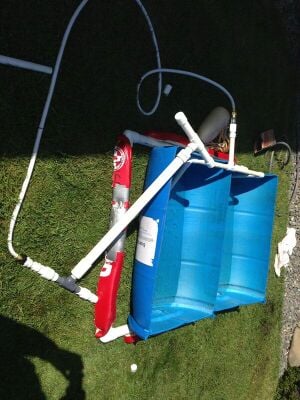
Water Pump[edit | edit source]
The water pump assembled for the WetLand bog can fill 1/4 of the 55 gallon drum with water at an estimate of 200 pumps and can drain out that amount of water with 300 pumps. These system can check for water quality and monitoring during low and high tides as needed. Water pump is easily attachable with a hose ending into the Inlet and Outlet System.
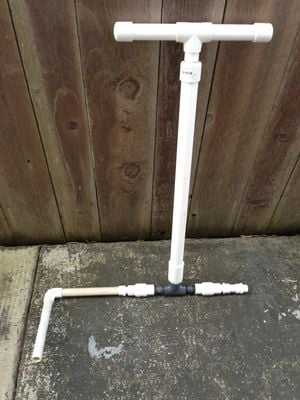
Materials[edit | edit source]
- 1 1x1/2"x30" PVC
- 1 1x1/2" PVC cap
- 1 1"x36" PVC
- 1 1" t-joint
- 1 can PVC glue
- 2 1"x4" PVC
- 2 1" PVC cap
- 2 1x1/2 rubber o-rings
- 2 3/4" check valves
- 1 1x1/2"male coupling
- 2 3/4" PVC nipple
- 1 3/4" t-joint
- 2 3/4" male threaded couplings
Instructional video[edit | edit source]
More information on this water pump and its potential can be found in the video below and in our WetLand bog video at the bottom of this Appropredia page:
PVC Frame[edit | edit source]
The bog frame will not take much time to construct, however, precision cutting of the PVC pipelines to desired length as well as the cementing of the frame should be done patiently. Four buoy pieces were screw onto the outside of the frame for added buoyancy (buoy use in WetLand bog is graded for commercial use at 200lbs.)
-
Complete PVC frame at the Mad River
-
PVC frame
Materials[edit | edit source]
- 14'x1-1/2" PVC pipe
- 4x 1-1/2" x 90 degree fittings
- PVC cement
- small screws
- 2 small Buoys
- 12' rope
- Fender washers
Instructions[edit | edit source]
- Cut 2x1-1/2" PVC pipe into 2 x 4' pieces.
- Then get two more 1-1/2" PVC pipe and cut 2 x 3' pieces.
- Connect the frame with 4 x 90 degree fittings, make sure all four sides are even.
- Cement the inside of the 90 degree fittings and outside ends of the PVC pieces, (make sure frame sits straight on flat surface so it wont bend with cementing fittings).
- Let the cement dry
- Cut a buoy into 4 equal pieces (buoy has to be long enough to extend to the sides of the PVC frame).
- Screw the 4 equal pieces of buoy onto the PVC frame with small screws and washers, 4 screws and 4 washers per side.
- Then tie up a 12' rope around the PVC frame along with a buoy to dock the bog.
Drum frame[edit | edit source]
-
Cleaning up the materials
-
Drum frame
-
Sectioned 55-gallon drum attached to the yoke.
The Drum Fame is a relatively quick build. The 55-gallon drum and boards could be substituted for larger or smaller sizes depending upon available resources.
Materials[edit | edit source]
- 1 55 gallon drum
- 20 wood screws
- 1 45" x 2" x 4" board
- 2 36" x 1/2" x 4" board
Instructions[edit | edit source]
- Rinse off the inside and outside of 55 gallon drum.
- Mark the top and bottom at the diameter.
- Stretch a chalk line from the top to the bottom and snap a line. Repeat until all four sides of drum are marked.
- Cut the drum longitudinally.
- Cut (1) board 2" x 4" at 45"
- Place drum sections parallel on even surface. Line up drum ends.
- Place 45"x 2"x 4" board in between sections.
- Flush the drum sections to the 2"x4" and clamp in place.
- Using 1(1/2") wood screws fasten both sections to the 2" x 4" board.
- Mark the underside of the 2" x 4" on both ends to make a saddle notch.
- Cut out saddle notch.
- Insert Drum Frame into PVC frame. Making sure to align saddle notches of both the PVC and Drum frame.
- Drill a few holes in each of the drum sections approximately 1" below the top. (overflow)
Inlet/Outlet system[edit | edit source]
The inlet/outlet system is one of the most complicated and labor-intensive parts of the entire WetLand bog. After much trial and error the plans for the system that worked the best for our prototype bog are as follows:
Materials[edit | edit source]
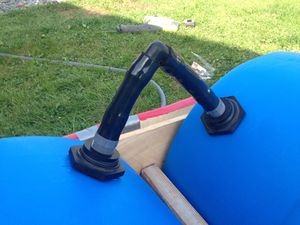
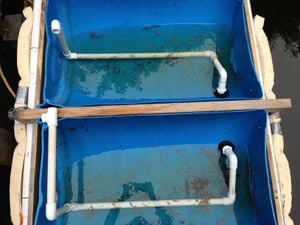
- 8 (3/4") x 90-degree fittings
- 1 (3/4") hose fitting
- 1 (3/4") nipple threaded
- 1 (3/4") female coupling threaded
- 2 (3/4") male threaded adapter
- 2 (3/4") bulkhead fitting
- 2 (3/4") to 1" male threaded adapter
- 2 1" Barbed insert to 1"
- 1 Barbed Insert Elbow
- 1' Black Tubing - 1"
- 1 (3/4") PVC t-joint
- PVC glue
- ~70" (3/4") PVC pipe
Instructions[edit | edit source]
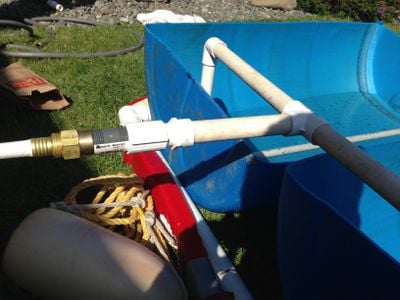
- Obtain all materials.
- Mark each section of the drum at 4" from the end.
- Drill out and insert bulk head fittings at the 4" mark.
- Attach 1" barbed insert to 1" to each bulk head.
- Cut the 1" black tubing in half and attach to barbed inserts.
- Attach barbed insert elbow to black tubing ends.
- Assemble the hose connection by inserting a 3/4" hose fitting to 3/4" nipple.
- Screw nipple into 3/4" female threaded coupling.
- Screw female threaded coupling into 3/4" male threaded adapter.
- Attach 6-8" of 3/4" PVC to 3/4" male threaded adapter.
- Attach (3/4") t-joint to PVC.
- Insert 6" of 3/4" PVC into either side of t-joint.
- Attach 90 degree elbow fitting to both ends of PVC.
- Insert 7" of PVC into each elbow.
- Attach 90 degree elbow to both ends of PVC.
- Cut 2 pieces of 3/4" PVC tubing at 40".
- Drill 3/16" holes every 4-6" on one side of both 40" PVC sections.
- Attach PVC tubing to 90 degree fittings, with holes facing down.
- Attach 90 degree fitting to PVC tubing.
- Insert 4" PVC tubing into each 90 degree fitting.
- Attach 90 degree fitting to each PVC section.
- Insert 1" PVC tubing to 90 degree fitting.
- Attach 3/4" male threaded adapter to bulk head fitting and attach PVC tubing.
- Attach 3/4" male threaded adapter to the other bulk head fitting.
- Disassemble parts and glue all connections.
Testing[edit | edit source]
Testing of the constructed bog began on April 29, 2014, and lasted until May 11, 2014. A variety of parameters were tested both visually and mechanically. Our original test site was a location along the Mad River. We eventually obtained permission to test the bog at Fern Lake.
-
PVC Frame at test site
-
First Buoyancy test: PVC tube with water bottles - Duration in the water 30 minutes test
-
Taylor testing for buoyancy - Test time 15 minutes in the Mad River
Buoyancy[edit | edit source]
Buoyancy testing began with a single capped PVC tube, which we found to be surprisingly buoyant. We then tested the same tube with plastic water bottle lids screwed directly into the PVC tube. This was also surprisingly buoyant. We then filled each bottle with water and found the PVC tube to displace enough water with the added weight to float just above the waterline. Testing progressed to the PVC frame of our final design. We added a quartered lifeguard buoy for extra buoyancy. With the request of our client for a water quality monitoring system, we eventually added the sectioned 55-gallon drum to the PVC frame. Testing of the PVC frame and the 55-gallon drum proved buoyant. We filled the drum with 40 gallons of water, a 170-pound team member hopped in wearing a 30 lbs weight belt and the bog still floated. Our results show that PVC when capped and sealed is buoyant. The sectioned 55-gallon drum also proved to be buoyant and when combined the two were able to maintain positive buoyancy with over 500 pounds added.
170lbs(teammate)+30lbs(weight belt)+(40gal of fresh water*8.34lbs/gal fresh water)= 533.6lbs.
Pressure[edit | edit source]
Pressure testing begins by adding half of the teammate's body weight which totaled 85lbs onto the PVC frame. The Frame remained steady only tilting to the sides when pressure was added significantly to one side of the bog. Another test took place in which a group member tried to submerge the bog in Fern Lake from the sides of the 55-gallon drum and middle border connecting the halve drums. With 190lbs of pressure, it did not tilt or submerge the bog from the middle border. The sides of the PVC frame did experience submergence in the water but did not cause any damage to the bog.
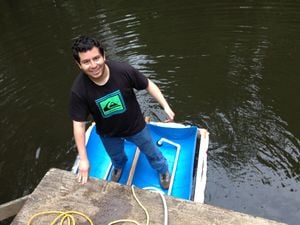
Water Quality[edit | edit source]
Water quality was monitored once a day over four days. We checked the PH, turbidity, dissolved Oxygen, and Salinity of the bog. We also tested the water at the test site for comparison. Results are as follows.
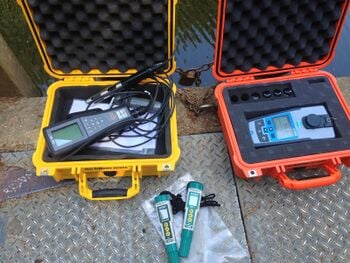
| Date | Fern Lake | Bog |
|---|---|---|
| 5/8/14 | 7.64 | 6.87 |
| 5/9/14 | 7.38 | 6.68 |
| 5/10/14 | 7.70 | 6.90 |
| 5/11/14 | 7.95 | 6.85 |
| Date | Fern Lake(NTU) | Bog (NTU) |
|---|---|---|
| 5/8/14 | 4.16 | 5.20 |
| 5/9/14 | 4.79 | 6.29 |
| 5/10/14 | 4.68 | 12.70 |
| 5/11/14 | 4.57 | 7.34 |
| Date | Fern Lake(%) | Bog (%) |
|---|---|---|
| 5/8/14 | 102.1 | 34.5 |
| 5/9/14 | 103.7 | 42.5 |
| 5/10/14 | 104.9 | 63.7 |
| 5/11/14 | 101.3 | 57.2 |
| Date | Fern Lake(%) | Bog (%) |
|---|---|---|
| 5/8/14 | 90.9 | 38.5 |
| 5/9/14 | 91.7 | 38.3 |
| 5/10/14 | 91.7 | 20.4 |
| 5/11/14 | 92.0 | 27.9 |
Plants[edit | edit source]
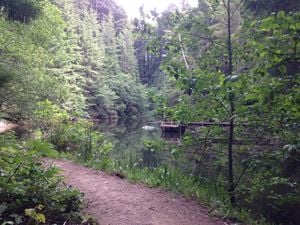
We chose to use non-invasive local plants for the prototype bog. Plants were obtained from the surrounding landscape at the test site. Information on appropriate plants was obtained from staff and students at Cal Poly Humboldt.[11]
For testing purposes, we planted a variety of local flora.
- Skunk Cabbage sp: Lysichiton americanus
- Horsetail sp: Spenophyta
- Lilly sp: Erythronium hendersonii S. Watson
Operation[edit | edit source]
This is how to successfully operate the bog. Once planted the bog will require visual inspection, water quality analysis and should be flushed 2-3 times per week.
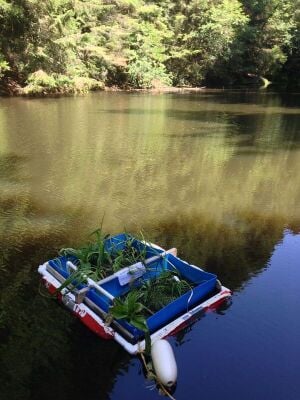
Maintenance[edit | edit source]
Maintenance of the bog should be performed daily, weekly, and monthly. Maintenance consists of visual monitoring for undesirable materials, leaks, plant health, and water quality analysis.
Schedule[edit | edit source]
- Daily
- Visual inspection for undesirable materials.
- Visual inspection for leaks.
- Visual inspection of overall plant health.
- Weekly
- Water quality analysis.
- 2-3 times per week the bog should be drained and injected with new water.
- Monthly
- Flush entire system, including check valves and pump.
- Re-plant as necessary.
Video[edit | edit source]
Conclusion[edit | edit source]
Discussion[edit | edit source]
The prototype bog we built is 4'x3' (1/4) the scale of the final project. The design we have come up with can easily be manipulated and expanded upon to meet the final scale of 16'x3'. Our prototype serves as the basic building block for the final installation. Each PVC Fame and drum frame allows for easy expansion to a larger size with the addition of many of the same parts.
Lessons Learned[edit | edit source]
- Perforated pipe for inlet/outlet system, may not need as many holes on the intake side.
- Drums connected in series
- Capped PVC is very buoyant
- Make sure to add primer and enough PVC cement to the elbows and fittings. Allow plenty of time for PVC cement to dry.
- Plants in bogs should be monitor daily for water quality assurance.
- Plan out before executing any component of the bog, assure security to save time and money.
- When building any component of the bog, especially PVC frame, make sure the frame is straight while cementing.
- Watch out for air pockets in water pump, can make a big difference in the pressure of water going in and out the bog.
- When making the water pump be extra careful placing the O-rings edges around the PVC pipe.
- Bogs are awesome Appropriate Technology.
Team[edit | edit source]
The members who are responsible for the Wetland bog prototype for the Spring 2014 semester, Engineering 305 (Appropriate Technology) course at Cal Poly Humboldt.
References[edit | edit source]
Most of the references use in this section are for Eastern states native flora as this project will be projected in Philadelphia. Check USDA for plant habitat suitability.
- ↑ U.S Army Core of Engineers[1]
- ↑ [Kulser, Jon A; Kentula, Mary E. 1990. Wetland Creation and Restoration. The Status of the Science]
- ↑ [Mitsch, Willam J; Gosselink, James G. 2007. Wetlands 4th Edition. ]
- ↑ Moore, Peter D.. (2001). Wetlands. New York: Facts on File.
- ↑ [Building Floating Wetlands to Restore Urban Waterfronts and Community Partnership]
- ↑ USDA legal status plants
- ↑ City of Philadelphia. Invasive Plant List [2]
- ↑ Among the Stately Trees, wordpress. (2013). "The top 75 Wetland Plants", Lehigh University.
- ↑ Tyler Kimberly, Ruan Michelle. 2012. "Edible and Medicinal Plants", SUNY Plattsburgh, NY. http://edibleandmedicinalplants.weebly.com/index.html.
- ↑ http://www.state.nj.us/drbc/library/documents/WQAssessmentReport2012.pdf
- ↑ http://www.appropedia.org/Emergent_plants_for_constructed_wetlands.

